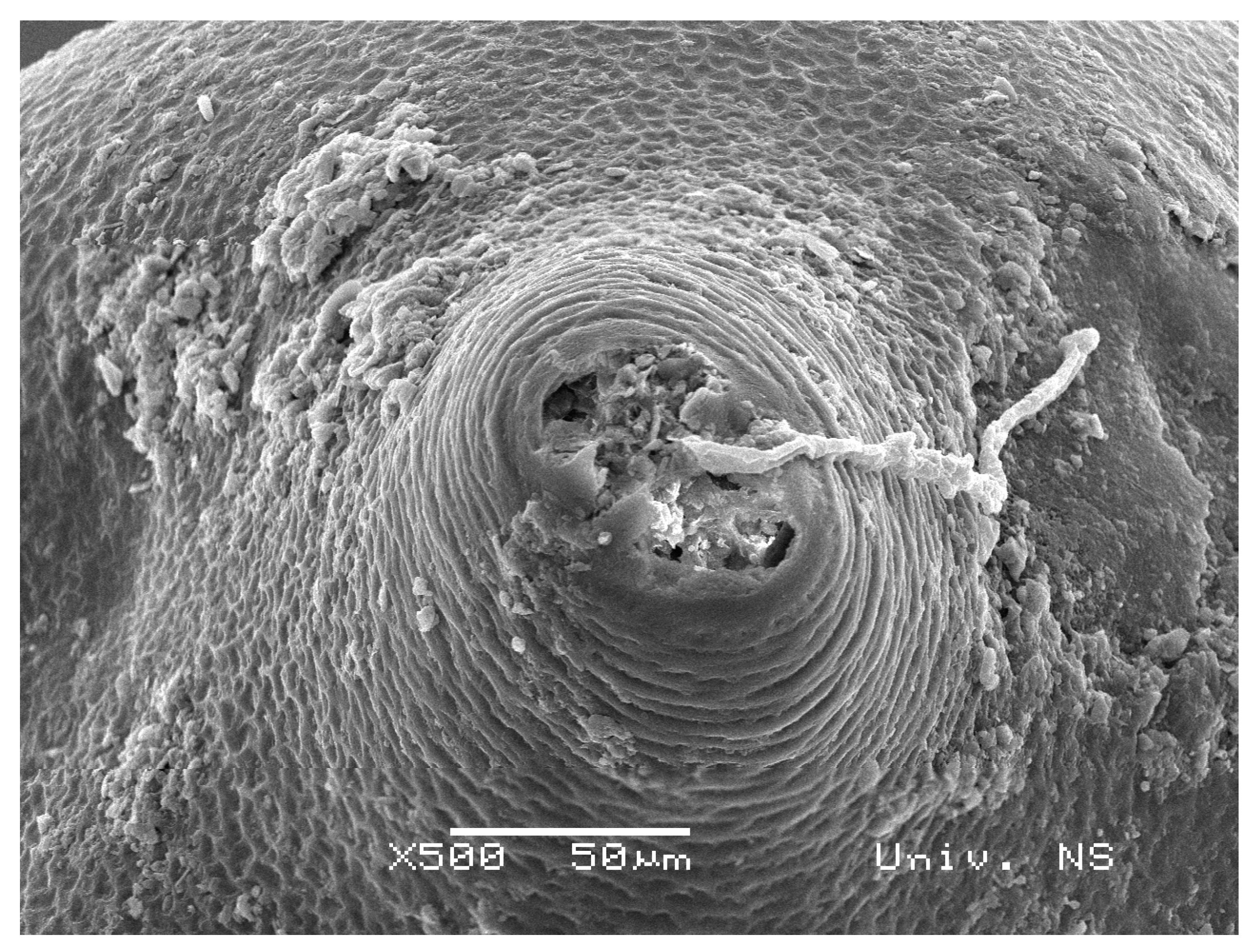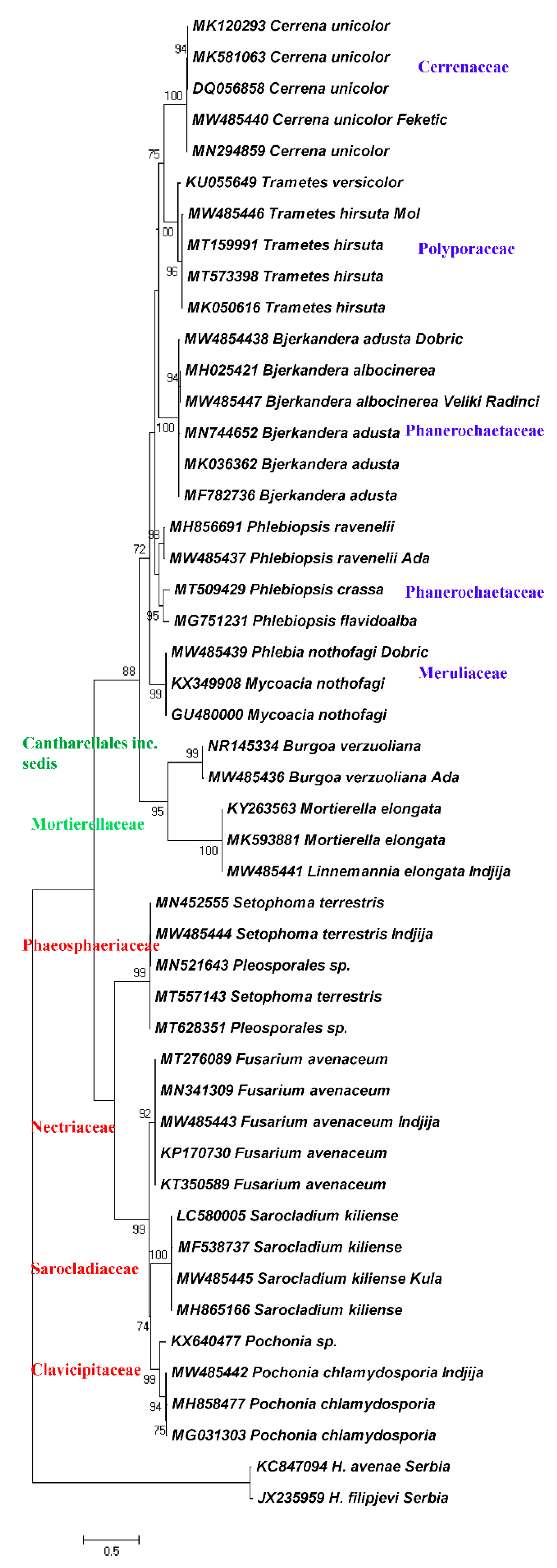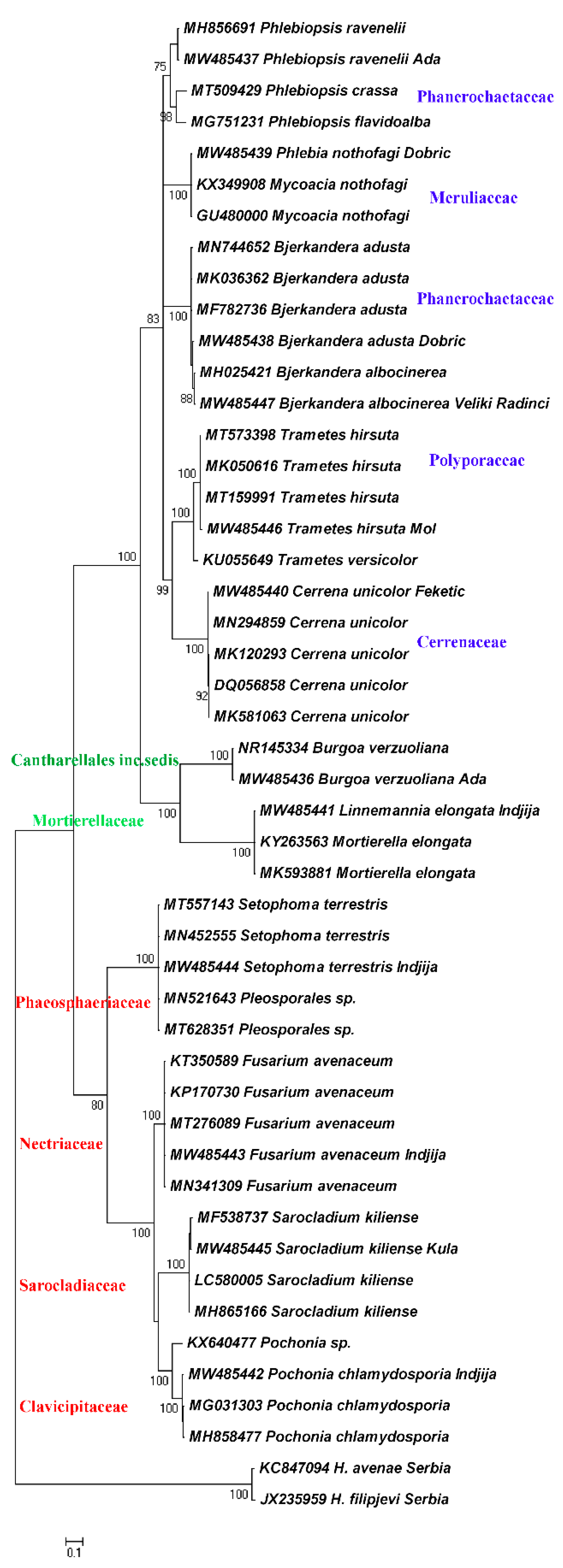Diversity of Mycobiota Associated with the Cereal Cyst Nematode Heterodera filipjevi Originating from Some Localities of the Pannonian Plain in Serbia
Abstract
Simple Summary
Abstract
1. Introduction
2. Materials and Methods
2.1. Isolation of Nematodes and Fungi
2.2. Molecular Study
3. Results and Discussion
4. Conclusions
Author Contributions
Funding
Institutional Review Board Statement
Informed Consent Statement
Data Availability Statement
Acknowledgments
Conflicts of Interest
References
- Medovic, A. Najbolje iz preistorijske Vojvodine: Starčevačka jednozrna pšenica, „kasna“, i južnobanatski proso, „rani.“ Fosilni biljni ostaci sa lokaliteta Starčevo. Grad. Rad Muz. Vojv. 2011, 53, 143–149. (In Serbian) [Google Scholar]
- Nicol, J.M.; Turner, S.J.; Coyne, D.; Nijs, L.D.; Hockland, S.; Maafi, Z.T. Current nematode threats to World Agriculture. In Genomics and Molecular Genetics of Plant-Nematode Interactions; Jones, J., Gheysen, G., Fenoll, C., Eds.; The Springer Science Netherland Business Media LLC.: Dordrecht, The Netherlands, 2011; pp. 21–43. [Google Scholar] [CrossRef]
- Oro, V.; Knezevic, M.; Dinić, Z.; Delic, D. Bacterial Microbiota Isolated from Cysts of Globodera rostochiensis (Nematoda: Heteroderidae). Plants 2020, 9, 1146. [Google Scholar] [CrossRef] [PubMed]
- Hu, W.; Samac, D.A.; Liu, X.; Chen, S. Microbial communities in the cysts of soybean cyst nematode affected by tillage and biocide in a suppressive soil. Appl. Soil Ecol. 2017, 119, 396–406. [Google Scholar] [CrossRef]
- Siddiqui, Z.A.; Mahmood, I. Biological control of plant parasitic nematodes by fungi: A review. Bioresour. Technol. 1996, 58, 229–239. [Google Scholar] [CrossRef]
- Mankau, R. Biocontrol: Fungi as nematode control agents. J. Nematol. 1980, 12, 244–252. [Google Scholar] [PubMed]
- Barron, G.L. Predatory fungi, wood decay, and the carbon cycle. Biodiversity 2003, 4, 3–9. [Google Scholar] [CrossRef]
- Jansson, H.-B.; Von Hofsten, A.; Von Mecklenburg, C. Life cycle of the endoparasitic nematophagous fungus Meria coniospora: A light and electron microscopic study. Antonie Leeuwenhoek 1984, 50, 321–327. [Google Scholar] [CrossRef]
- Kerry, B. Biocontrol: Fungal parasites of female cyst nematodes. J. Nematol. 1980, 12, 253–259. [Google Scholar] [PubMed]
- Nigh, E.A.; Thomason, I.J.; van Gundy, S.D. Identification and distribution of fungal parasites of Heterodera schachtii eggs in California. Phytopathology 1980, 70, 884–889. [Google Scholar] [CrossRef]
- Lopez-Llorca, L.V.; Duncan, G.H. Effects of fungal parasites on cereal cyst nematode (Heterodera avenae Woll.) from naturally infested soil—A scanning electron microscopy study. Can. J. Microbiol. 1991, 37, 218–225. [Google Scholar] [CrossRef]
- Khan, A.; Williams, K.L.; Nevalainen, H.K.M. Infection of plant-parasitic nematodes by Paecilomyces lilacinus and Monacrosporium lysipagum. BioControl 2006, 51, 659–678. [Google Scholar] [CrossRef]
- Hu, W.; Strom, N.; Haarith, D.; Chen, S.; Bushley, K.E. Mycobiome of cysts of the soybean cyst nematode under long term crop rotation. Front. Microbiol. 2018, 9, 386. [Google Scholar] [CrossRef] [PubMed]
- Hallmann, J.; Sikora, R.A. Toxicity of fungal endophyte secondary metabolites to plant parasitic nematodes and soil-borne plant pathogenic fungi. Eur. J. Plant Pathol. 1996, 102, 155–162. [Google Scholar] [CrossRef]
- Nitao, J.; Meyer, S.; Chitwood, D.; Schmidt, W.; Oliver, J. Isolation of flavipin, a fungus compound antagonistic to plant-parasitic nematodes. Nematology 2002, 4, 55–63. [Google Scholar] [CrossRef]
- Coyne, D.L.; Nicol, J.M.; Claudius-Cole, B. Practical Plant Nematology: A Field and Laboratory Guide, 2nd ed.; SP-IPM Secretariat International Institute of Tropical Agriculture (IITA): Cotonou, Benin, 2014; pp. 25–29. [Google Scholar]
- Spears, J.F. The Golden Nematode Handbook-Survey, Laboratory, Control and Quarantine Procedures. Agriculture Handbook 353; USDA, Agricultural Research Service: Washington, DC, USA, 1968; pp. 1–82. [Google Scholar]
- Heungens, K.; Mugniery, D.; Van Montagu, M.; Gheysen, G.; Niebel, A. A method to obtain disinfected Globodera infective juveniles directly from cysts. Fundam. Appl. Nematol. 1996, 19, 91–93. [Google Scholar]
- Gams, W.; Hoeskstra, E.S.; Aptroot, A.; Van der Aa, H.A. CBS Course of Mycology, 4th ed.; Centraalbureau voor Schimmelcultures: Baarn, The Netherlands, 1998; pp. 1–165. [Google Scholar]
- Shepherd, A.M.; Clark, S.A. Preparation of nematodes for electron microscopy. In Laboratory Methods for Work with Plant and Soil Nematodes; Southey, J.F., Ed.; Ministry of Agriculture, Fisheries and Food: London, UK, 1986; pp. 121–131. [Google Scholar]
- Sequerra, J.; Marmeisse, R.; Valla, G.; Normand, P.; Capellano, A.; Moiroud, A. Taxonomic position and intraspecific variability of the nodule forming Penicillium nodositatum inferred from RFLP analysis of the ribosomal intergenic spacer and Random Amplified Polymorphic DNA. Mycol. Res. 1997, 101, 465–472. [Google Scholar] [CrossRef]
- Skantar, A.M.; Handoo, Z.A.; Carta, L.K.; Chitwood, D.J. Morphological and molecular identification of Globodera pallida associated with potato in Idaho. J. Nematol. 2007, 39, 133–144. [Google Scholar] [PubMed]
- Guindon, S.; Gascuel, O. A simple, fast, and accurate algorithm to estimate large phylogenies by maximum likelihood. Syst. Biol. 2003, 52, 696–704. [Google Scholar] [CrossRef]
- Huelsenbeck, J.P.; Ronquist, F. Bayesian analysis of molecular evolution using MrBayes. In Statistical Methods in Molecular Evolution: Statistics for Pharmaceutical and Biotechnology Industries and Health; Metzler, J.B., Ed.; Springer: New York, NY, USA, 2005; pp. 183–226. [Google Scholar] [CrossRef]
- Tamura, K.; Dudley, J.; Nei, M.; Kumar, S. Mega4: Molecular evolutionary genetics analysis (MEGA) Software version 4.0. Mol. Biol. Evol. 2007, 24, 1596–1599. [Google Scholar] [CrossRef]
- Clarke, A.J.; Cox, P.M.; Shepherd, A.M.; Prior, A.; Jones, J.T.; Blok, V.C.; Beauchamp, J.; McDermott, L.; Cooper, A.; Kennedy, M.W.; et al. The chemical composition of the egg shells of the potato cyst-nematode, Heterodera rostochiensis Woll. Biochem. J. 1967, 104, 1056–1060. [Google Scholar] [CrossRef] [PubMed][Green Version]
- Manzanilla-López, R.H.; Esteves, I.; Finetti-Sialer, M.M.; Hirsch, P.R.; Ward, E.; Devonshire, J.; Hidalgo-Díaz, L. Pochonia chlamydosporia: Advances and challenges to improve its performance as a biological control agent of sedentary endo-parasitic nematodes. J. Nematol. 2013, 45, 1–7. [Google Scholar] [PubMed]
- De Souza Gouveia, A.; Monteiro, T.S.A.; Valadares, S.V.; Sufiate, B.L.; De Freitas, L.G.; de Oliveira Ramos, H.J.; De Queiroz, J.H. Understanding how Pochonia chlamydosporia increases phosphorus availability. Geomicrobiol. J. 2019, 36, 747–751. [Google Scholar] [CrossRef]
- Shemshura, O.N.; Bekmakhanova, N.E.; Mazunina, M.N.; Meyer, S.L.F.; Rice, C.P.; Masler, E.P. Isolation and identification of nematode-antagonistic compounds from the fungus Aspergillus candidus. FEMS Microbiol. Lett. 2016, 363, 1–9. [Google Scholar] [CrossRef] [PubMed][Green Version]
- Ayatollahy, E.; Fatemy, S.; Etebarian, H.R. Potential for biological control of Heterodera schachtii by Pochonia chlamydosporiavar. chlamydosporia on sugar beet. Biocontrol Sci. Technol. 2008, 18, 157–167. [Google Scholar] [CrossRef]
- Oro, V.; Tabakovic, M. Phylogeography of some European populations of the sugar beet cyst nematode. Russ. J. Nematol. 2020, 28, 91–98. [Google Scholar] [CrossRef]
- Summerbell, R.; Gueidan, C.; Schroers, H.-J.; De Hoog, G.; Starink, M.; Rosete, Y.A.; Guarro, J.; Scott, J.A. Acremonium phylogenetic overview and revision of Gliomastix, Sarocladium, and Trichothecium. Stud. Mycol. 2011, 68, 139–162. [Google Scholar] [CrossRef]
- Hou, Y.M.; Zhang, X.; Zhang, N.N.; Naklumpa, W.; Zhao, W.Y.; Liang, X.F.; Zhang, R.; Sun, G.Y.; Gleason, M.L. Genera Acremonium and Sarocladium cause brown spot on bagged apple fruit in China. Plant Dis. 2019, 103, 1889–1901. [Google Scholar] [CrossRef] [PubMed]
- Divilov, K.; Walker, D.R. Reaction of Diaporthe longicolla to a strain of Sarocladium kiliense. Biocontrol Sci. Technol. 2016, 26, 938–950. [Google Scholar] [CrossRef]
- Gamboa-Angulo, M.; Moreno-Escobar, J.A.; Herrera-Parra, E.; Pérez-Cruz, J.; Cristóbal-Alejo, J.; Heredia-Abarca, G. Toxicidad in vitro de micromicetos del tropico Mexicano en juveniles infectivos de Meloidogyne incognita. Revista Mexicana de Fitopatología, Mex. J. Phytopathol. 2015, 34. [Google Scholar] [CrossRef]
- Uhlig, S.; Jestoi, M.; Parikka, P. Fusarium avenaceum—The North European situation. Int. J. Food Microbiol. 2007, 119, 17–24. [Google Scholar] [CrossRef] [PubMed]
- Vogelgsang, S.; Sulyok, M.; Hecker, A.; Jenny, E.; Krska, R.; Schuhmacher, R.; Forrer, H.-R. Toxigenicity and pathogenicity of Fusarium poae and Fusarium avenaceum on wheat. Eur. J. Plant Pathol. 2008, 122, 265–276. [Google Scholar] [CrossRef]
- Singh, S.; Mathur, N. In vitro studies of antagonistic fungi against the root-knot nematode, Meloidogyne incognita. Biocontrol Sci. Technol. 2010, 20, 275–282. [Google Scholar] [CrossRef]
- Orio, A.G.A.; Brücher, E.; Ducasse, D.A. A strain of Bacillus subtilis subsp. subtilis shows a specific antagonistic activity against the soil-borne pathogen of onion Setophoma terrestris. Eur. J. Plant Pathol. 2016, 144, 217–223. [Google Scholar] [CrossRef]
- Szűcs, Z.; Plaszkó, T.; Cziáky, Z.; Kiss-Szikszai, A.; Emri, T.; Bertóti, R.; Sinka, L.T.; Vasas, G.; Gonda, S. Endophytic fungi from the roots of horseradish (Armoracia rusticana) and their interactions with the defensive metabolites of the glucosinolate—myrosinase—isothiocyanate system. BMC Plant Biol. 2018, 18, 85. [Google Scholar] [CrossRef] [PubMed]
- Chen, S.Y.; Dickson, D.W.; Mitchell, D.J. Pathogenicity of fungi to eggs of Heterodera glycines. J. Nematol. 1996, 28, 148–158. [Google Scholar] [PubMed]
- Sidorova, I.; Voronina, E. Bioactive secondary metabolites of basidiomycetes and its potential for agricultural plant growth promotion. In Secondary Metabolites of Plant Growth Promoting Rhizomicroorganisms; Metzler, J.B., Ed.; Springer: Singapore, 2019; pp. 3–26. [Google Scholar]
- Moreno, G.; Blanco, M.-N.; Checa, J.; Platas, G.; Peláez, F. Taxonomic and phylogenetic revision of three rare irpicoid species within the Meruliaceae. Mycol. Prog. 2010, 10, 481–491. [Google Scholar] [CrossRef]
- Kamei, I.; Uchida, K.; Ardianti, V. Conservation of xylose fermentability in Phlebia species and direct fermentation of xylan by selected fungi. Appl. Biochem. Biotechnol. 2020, 192, 895–909. [Google Scholar] [CrossRef]
- Behrendt, C.J.; Blanchette, R.A. Biological processing of pine logs for pulp and paper production with Phlebiopsis gigantea. Appl. Environ. Microbiol. 1997, 63, 1995–2000. [Google Scholar] [CrossRef] [PubMed]
- Tzean, S.S.; Liou, J.Y. Nematophagous resupinate basidiomycetous fungi. Phytopathology 1993, 83, 1015–1020. [Google Scholar] [CrossRef]
- Motato-Vásquez, V.; Gugliotta, A.M.; Rajchenberg, M.; Catania, M.; Urcelay, C.; Robledo, G. New insights on Bjerkandera (Phanerochaetaceae, Polyporales) in the Neotropics with description of Bjerkandera albocinerea based on morphological and molecular evidence. Plant Ecol. Evol. 2020, 153, 229–245. [Google Scholar] [CrossRef]
- Andriani, A.; Tachibana, S.; Itoh, K. Effects of saline-alkaline stress on benzo[a]pyrene biotransformation and ligninolytic enzyme expression by Bjerkandera adusta SM46. World J. Microbiol. Biotechnol. 2016, 32, 39. [Google Scholar] [CrossRef] [PubMed]
- Balaeş, T.; Tănase, C. Basidiomycetes as potential biocontrol agents against nematodes. Rom. Biotech. Lett. 2016, 21, 11185–11193. [Google Scholar]
- Patil, P.D.; Yadav, G.D. Comparative studies of white-rot fungal strains (Trametes hirsuta MTCC-1171 and Phanerochaete chrysosporium NCIM-1106) for effective degradation and bioconversion of ferulic acid. ACS Omega 2018, 3, 14858–14868. [Google Scholar] [CrossRef]
- Taghinasab, M.; Imani, J.; Steffens, D.; Kogel, K.-H. The root endophytes Trametes versicolor and Piriformospora indica increase grain yield and P content in wheat. Plant Soil 2018, 426, 339–348. [Google Scholar] [CrossRef]
- Gianfreda, L.; Sannino, F.; Filazzola, M.T.; Leonowicz, A. Catalytic behavior and detoxifying ability of a laccase from the fungal strain Cerrena unicolor. J. Mol. Catal. B Enzym. 1998, 4, 13–23. [Google Scholar] [CrossRef]
- Gorbatova, O.; Koroleva, O.; Landesman, E.; Stepanova, E.; Zherdev, A. Increase of the detoxification potential of basidiomycetes by induction of laccase biosynthesis. Appl. Biochem. Microbiol. 2006, 42, 414–419. [Google Scholar] [CrossRef]
- Lawrey, J.D.; Binder, M.; Diederich, P.; Molina, M.C.; Sikaroodi, M.; Ertz, D. Phylogenetic diversity of lichen-associated homobasidiomycetes. Mol. Phylogen. Evol. 2007, 44, 778–789. [Google Scholar] [CrossRef] [PubMed]
- Selbmann, L.; Grube, M.; Onofri, S.; Isola, D.; Zucconi, L. Antarctic epilithic lichens as niches for black meristematic fungi. Biology 2013, 2, 784–797. [Google Scholar] [CrossRef] [PubMed]
- Diederich, P.; Lawrey, J.D. New lichenicolous, muscicolous, corticolous and lignicolous taxa of Burgoa sl and Marchandiomyces sl (anamorphic Basidiomycota), a new genus for Omphalina foliacea, and a catalogue and a key to the non-lichenized, bulbilliferous basidiomycetes. Mycol. Prog. 2007, 6, 61–80. [Google Scholar] [CrossRef]
- Kiyuna, T.; An, K.-D.; Kigawa, R.; Sano, C.; Miura, S.; Sugiyama, J. “Black particles”, the major colonizers on the ceiling stone of the stone chamber interior of the Kitora Tumulus, Japan, are the bulbilliferous basidiomycete fungus Burgoa anomala. Mycoscience 2015, 56, 293–300. [Google Scholar] [CrossRef]
- Zhang, K.; Bonito, G.; Hsu, C.-M.; Hameed, K.; Vilgalys, R.; Liao, H.-L. Mortierella elongata increases plant biomass among non-leguminous crop species. Agronomy 2020, 10, 754. [Google Scholar] [CrossRef]
- Li, F.; Chen, L.; Redmile-Gordon, M.; Zhang, J.; Zhang, C.; Ning, Q.; Li, W. Mortierella elongata’s roles in organic agriculture and crop growth promotion in a mineral soil. Land Degrad. Dev. 2018, 29, 1642–1651. [Google Scholar] [CrossRef]
- Horel, A.; Schiewer, S. Microbial degradation of different hydrocarbon fuels with mycoremediation of volatiles. Microorganisms 2020, 8, 163. [Google Scholar] [CrossRef]
- Ilic-Stojanovic, S.; Nikolic, L.; Nikolic, V.; Petrovic, S.; Oro, V.; Mitic, Z.; Najman, S. Semi-crystalline copolymer hydrogels as smart drug carriers: In vitro thermo-responsive naproxen release study. Pharmaceutics 2021, 13, 158. [Google Scholar] [CrossRef] [PubMed]
- Yamada, H.; Shimizu, S.; Shinmen, Y. Production of arachidonic acid by Mortierella elongata 1S-5. Agric. Biol. Chem. 1987, 51, 785–790. [Google Scholar] [CrossRef]
- Vandepol, N.; Liber, J.; Desirò, A.; Na, H.; Kennedy, M.; Barry, K.; Grigoriev, I.V.; Miller, A.N.; O’Donnell, K.; Stajich, J.E. Resolving the Mortierellaceae phylogeny through synthesis of multi-gene phylogenetics and phylogenomics. Fungal Divers. 2020, 104, 267–289. [Google Scholar] [CrossRef] [PubMed]
- DiLegge, M.J.; Manter, D.K.; Vivanco, J.M. A novel approach to determine generalist nematophagous microbes reveals Mortierella globalpina as a new biocontrol agent against Meloidogyne spp. nematodes. Sci. Rep. 2019, 9, 7521. [Google Scholar] [CrossRef] [PubMed]
- Park, J.-H.; Pavlov, I.N.; Kim, M.-J.; Park, M.S.; Oh, S.-Y.; Park, K.H.; Fong, J.J.; Lim, Y.W. Investigating wood decaying fungi diversity in Central Siberia, Russia using ITS sequence analysis and interaction with host trees. Sustainability 2020, 12, 2535. [Google Scholar] [CrossRef]
- Martin, R.; Gazis, R.; Skaltsas, D.; Chaverri, P.; Hibbett, D. Unexpected diversity of basidiomycetous endophytes in sapwood and leaves of Hevea. Mycologia 2015, 107, 284–297. [Google Scholar] [CrossRef]
- Stierle, A.; Strobel, G. The search for a taxol-producing microorganism among the endophytic fungi of the Pacific yew, Taxus brevifolia. J. Nat. Prod. 1995, 58, 1315–1324. [Google Scholar] [CrossRef]
- Strobel, G.A.; Dirkse, E.; Sears, J.; Markworth, C. Volatile antimicrobials from Muscodor albus a novel endophytic fungus. Microbiology 2001, 147, 2943–2950. [Google Scholar] [CrossRef] [PubMed]
- Oro, V.; Krnjajic, S.; Tabakovic, M.; Stanojevic, J.S.; Ilic–Stojanovic, S. Nematicidal activity of essential oils on a psychrophilic Panagrolaimus sp. (Nematoda: Panagrolaimidae). Plants 2020, 9, 1588. [Google Scholar] [CrossRef] [PubMed]
- Parat, J. Forests and timber in ancient southern Pannonia. In Proceedings of the Scientific Conference with International Participation “Forests of Slavonia through history“, Slavonski Brod, Croatia, 1–2 October 2015; Zupan, D., Skenderovic, R., Eds.; Croatian Institute of History: Slavonski Brod, Croatia, 2015; pp. 15–40. [Google Scholar]
- Gavrilovic, V. The description of forests in Slavonia and Syrmia in the works of Friedrich Wilhelm von Taube and Frank Stefan Engel (The Description of the Kingdom of Slavonia and Syrmia). In Proceedings of the Scientific Conference with International Participation “Forests of Slavonia through history”, Slavonski Brod, Croatia, 1–2 October 2015; Zupan, D., Skenderovic, R., Eds.; Croatian Institute of History: Slavonski Brod, Croatia, 2015; pp. 131–140. [Google Scholar]
- Ducic, J. Biodiversity in Serbia-Status, trends and threats; Significance of biodiversity for human well-being. In Proceedings of the Fifth National Report to the United Nations Convention on Biological Diversity, Belgrade, Serbia, 15 August 2014; Ministry of Agriculture and Environmental Protection: Belgrade, Serbia, 2014; pp. 14–70. [Google Scholar]
- Jovanović, I.; Dragišić, A.; Ostojić, D.; Krsteski, B. Beech forests as world heritage in aspect to the next extension of the ancient and primeval beech forests of the Carpathians and other regions of Europe world heritage site. Zast. Prir. 2019, 69, 15–32. [Google Scholar] [CrossRef]




Publisher’s Note: MDPI stays neutral with regard to jurisdictional claims in published maps and institutional affiliations. |
© 2021 by the authors. Licensee MDPI, Basel, Switzerland. This article is an open access article distributed under the terms and conditions of the Creative Commons Attribution (CC BY) license (https://creativecommons.org/licenses/by/4.0/).
Share and Cite
Oro, V.; Stanisavljevic, R.; Nikolic, B.; Tabakovic, M.; Secanski, M.; Tosi, S. Diversity of Mycobiota Associated with the Cereal Cyst Nematode Heterodera filipjevi Originating from Some Localities of the Pannonian Plain in Serbia. Biology 2021, 10, 283. https://doi.org/10.3390/biology10040283
Oro V, Stanisavljevic R, Nikolic B, Tabakovic M, Secanski M, Tosi S. Diversity of Mycobiota Associated with the Cereal Cyst Nematode Heterodera filipjevi Originating from Some Localities of the Pannonian Plain in Serbia. Biology. 2021; 10(4):283. https://doi.org/10.3390/biology10040283
Chicago/Turabian StyleOro, Violeta, Rade Stanisavljevic, Bogdan Nikolic, Marijenka Tabakovic, Mile Secanski, and Solveig Tosi. 2021. "Diversity of Mycobiota Associated with the Cereal Cyst Nematode Heterodera filipjevi Originating from Some Localities of the Pannonian Plain in Serbia" Biology 10, no. 4: 283. https://doi.org/10.3390/biology10040283
APA StyleOro, V., Stanisavljevic, R., Nikolic, B., Tabakovic, M., Secanski, M., & Tosi, S. (2021). Diversity of Mycobiota Associated with the Cereal Cyst Nematode Heterodera filipjevi Originating from Some Localities of the Pannonian Plain in Serbia. Biology, 10(4), 283. https://doi.org/10.3390/biology10040283





